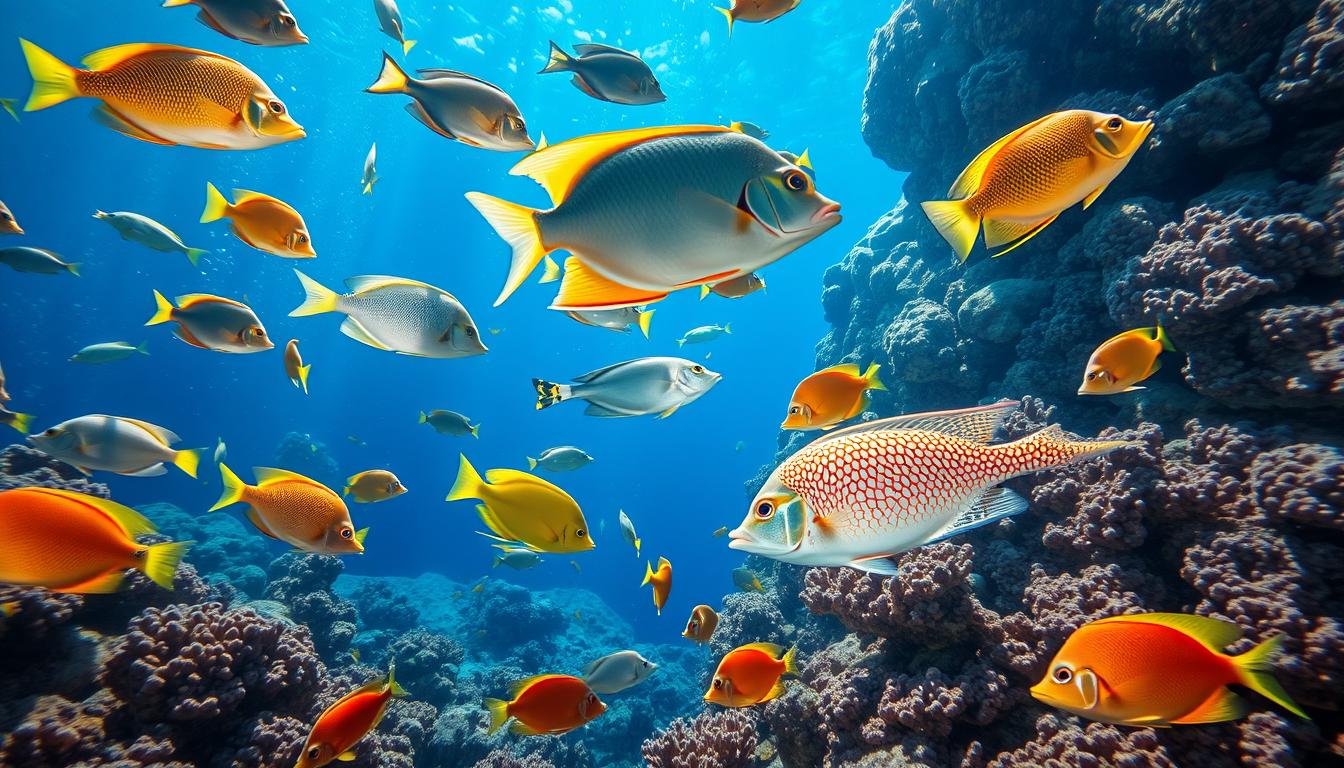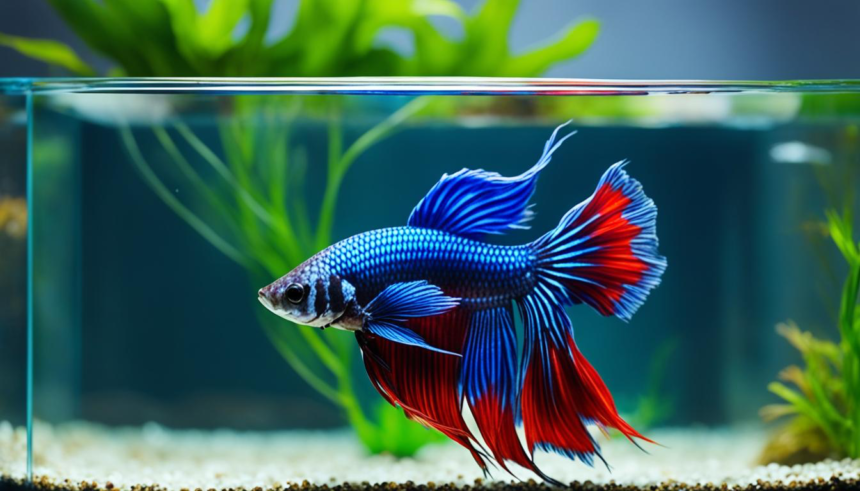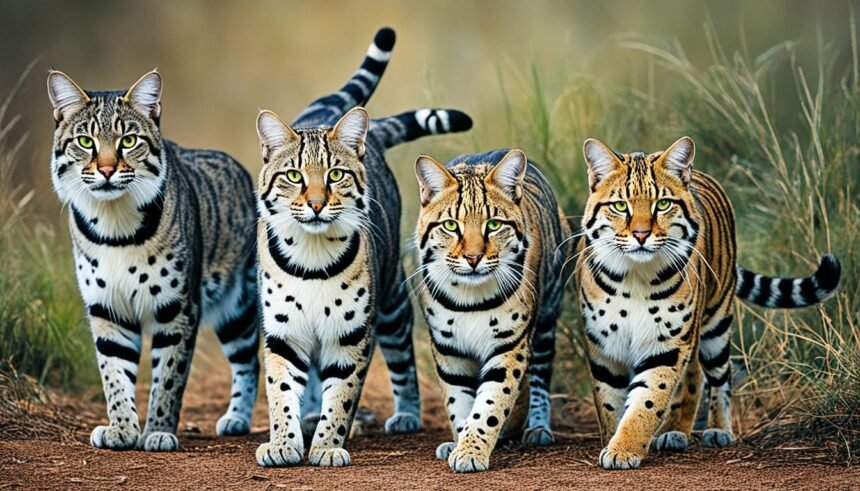Exploring the vibrant world of exotic fish can turn your aquarium into an underwater paradise. You’ll find mesmerizing colors like the Betta fish and the electric blue Acara. These creatures bring unique traits and care needs to your tank.
Whether you’re new to aquariums or have years of experience, finding the right exotic fish is rewarding. This guide will cover the most popular and stunning exotic fish species. You’ll learn about their characteristics, how they get along with others, and what they need to thrive.
Vibrant and Colorful Freshwater Fish
Freshwater fish are known for their bright and eye-catching colors. They are a favorite among aquarium fans. The guppy is a well-known and common species. They come in many colors, from classic to stunning albino.
Guppies: Affordable and Easy to Breed
Guppies are easy to breed and affordable. They do well in community tanks. They need a pH above 7.0 and lots of plants for shelter.
A good start is a trio of one male and two female guppies in a 10- or 20-gallon tank. You can find them at pet stores for as little as $3 each. But, be careful with fin-nipping tank mates. Their long tails can attract predators.
Guppies are loved by both new and seasoned aquarium fans. Their bright colors, hardiness, and easy breeding make them great. Plus, they’re affordable and easy to care for, perfect for any freshwater tank.
Captivating Schooling Fish
Schooling fish add magic to any freshwater aquarium. They move in sync and show off their bright colors. The cardinal tetra is a great example. It has a blue stripe and a red band that runs its whole body.
These fish are calm and grow to 2 inches long. They like to be in schools of at least 8. They do well in community tanks with lots of live plants for cover. This helps them feel safe and shows off their beauty.
Other amazing schooling fish include the neon tetra, tiger barbs, and pygmy corydoras catfish. These colorful fish need a school of 6-8 and a big enough tank.
| Fish Species | Adult Size | Minimum School Size | Ideal Tank Size |
|---|---|---|---|
| Neon Tetra | 1 inch | 8 | 15 gallons |
| Tiger Barb | 2-3 inches | 6 | 25 gallons |
| Pygmy Corydoras Catfish | 1 inch | 6 | 15 gallons |
| Cardinal Tetra | 1.5 – 2 inches | 8 | 15 gallons |
| Emperor Tetra | 1.5 inches | 6 | 15 gallons |
| Otocinclus Catfish | 2 inches | 6 | 15 gallons |
| Clown Loach | 6 – 8 inches | 5 | 75+ gallons |
| Harlequin Rasbora | 1.5 inches | 8 | 15 gallons |
| Celestial Pearl Danio | 1 inch | 6 | 15 gallons |
Adding schooling fish to your tank makes it lively and colorful. It’s a treat for you and your visitors.
Discus: The King of the Aquarium
Caring for Discus Fish
Discus fish are known as the “king of the aquarium” for their stunning looks and colors. They come in many beautiful shades like turquoise, pigeon blood, and albino yellow. But, they need special care, preferring warm water and large tanks of at least 75 gallons.
Keeping their water clean and stable is key for these sensitive fish. They can grow up to 7 inches in diameter. When cared for right, they can be a beautiful addition to a community tank. The discus fish industry in Asia, especially in Thailand, is huge, with shows and online breeders.
There are three main types of discus fish: blue or brown, red or Heckel, and green. A 2011 study found five main groups of discus fish, leading to their recognition as distinct species.
In the wild, discus fish can grow up to 9 inches long. In captivity, they can reach 23 cm (9 in) and weigh 150–250 g (5.3–8.8 oz). They don’t show sex differences until they’re about 4 inches long, making it hard to tell males from females at a young age. They are very social, often living in groups of dozens.
Discus fish in home aquariums can live up to 15 years. They need a tank of at least 55 US gal (210 L) – 75 US gal (280 L). To keep them healthy, you must maintain clean water, feed them right, and keep their environment quiet.
Peaceful Cichlids for Community Tanks
Many people think cichlids are always aggressive. But, there are peaceful South American cichlids perfect for community tanks. The German blue ram is a great example. It’s a colorful dwarf cichlid with shades of red, orange, yellow, blue, and white.
These 2-2.5 inch fish love warmer waters, between 84-86°F. They get along well with other peaceful fish like cardinal tetras, Sterbai cory catfish, plecos, angelfish, and other dwarf cichlids.
Choosing the right cichlid species can make your tank beautiful without aggression. Cichlids are known to be aggressive, with 20 to 30 percent showing this trait. But, picking the right ones can make your community tank thrive.
- German blue ram: A vibrant dwarf cichlid with a rainbow of colors
- Cockatoo Cichlids (Apistogramma cacatuoides): Popular for their bright yellow, orange, and blue hues
- Agassiz’s Dwarf Cichlids (Apistogramma agassizii): Sought after for their vibrant orange or red coloration
- Two-Stripe Dwarf Cichlids (Apistogramma bitaeniata): Known for their curious and active personality
By choosing the right cichlids and tank mates, you can create a stunning community tank. It will show off the beauty of these South American fish.
The Iconic Betta Fish
The betta fish, also known as the Siamese fighting fish, is a standout in the world of exotic freshwater fish. They are famous for their bright colors and unique tail shapes. These come in many varieties. However, betta fish need more than just a small container to survive. They require a 5-gallon tank with a heater and a sponge filter for gentle filtration.
Male betta fish are territorial and should live alone. This is unless you have a large community tank with plenty of hiding spots and live plants. With the right care and tank setup, betta fish can thrive and be a stunning addition to your home aquarium.
| Betta Fish Characteristics | Values |
|---|---|
| Size Range | 2 to 3 inches long |
| Average Lifespan in the Wild | 2 years |
| Average Lifespan in Captivity | 2 to 5 years |
| Water Temperature | 76°F to 80°F |
| pH Range | 6.5 to 7.5 |
| Minimum Tank Size | 5 gallons |
Betta fish are beloved pets for their stunning colors and long fins. But, they face threats in the wild like pollution and habitat loss. To keep these iconic fish happy and healthy, proper care and a suitable tank are key.
Rainbowfish: Splashes of Color

Rainbowfish are known for their bright, shimmering colors and fun schooling behavior. They stand out in any freshwater aquarium. The Boesemani rainbowfish is especially popular for its beautiful colors. It has iridescent blue on the front and vibrant orange on the back.
Boesemani rainbows are fast swimmers that can grow up to 4 inches long. They need a big tank, at least 4 feet long, to be happy. They get along well with peaceful fish like loaches, barbs, and giant danios. Keeping them in a school makes their colors and behavior even more impressive.
Boesemani Rainbowfish: A Stunning Addition
Boesemani rainbowfish are truly eye-catching. They have bright colors and sleek bodies. These fish come from Indonesia’s rivers and streams, where they live in groups.
To keep your Boesemani rainbows healthy, you need the right tank. A 30-gallon tank is best, with water between 72-82°F and pH 6.8-7.2. With the right setup, you’ll enjoy their beauty for many years.
Killifish: Hardy and Colorful
Killifish are vibrant and hardy, making them a great choice for any aquarium. The golden wonder killifish is especially stunning, with a bright yellow color. It can live up to 3 years, appealing to both beginners and experts.
These killifish love to eat and have big mouths. They do well on a protein-rich diet of bloodworms and brine shrimp. They’re active and grow to 3-4 inches, fitting well in community tanks with peaceful fish like rainbowfish and congo tetras.
Some killifish are short-lived or aggressive, but the golden wonder is different. It’s hardy and easy for beginners. Keeping them in cooler water helps them live longer, so you can enjoy their beauty for years.
Killifish are perfect for both new and seasoned aquarium fans. Their striking looks and easy care make them a great choice. Whether you choose the golden wonder or another colorful species, they’ll add beauty to your aquarium.
Peaceful Community Fish
Cherry barbs are perfect for those starting their aquarium journey. These 2-inch fish have a deep cherry-red color in males and a tannish-red in females. They are easy to care for and can handle different water conditions.
Cherry barbs do well in groups of at least six in a 10- or 20-gallon tank. They get along with other fish like tetras. They eat nano pellets, daphnia, and spirulina flakes, which keeps them healthy. Their bright colors and friendly nature make them great for beginners.
Cherry Barbs: A Beginner-Friendly Choice
Cherry barbs are loved for many reasons:
- Vibrant, cherry-red coloration in males
- Tolerant of a wide range of water parameters
- Peaceful nature, allowing them to coexist with other community species
- Small mouths, making them suitable for a varied diet
- Thrive in groups of at least six in a planted 10- or 20-gallon tank
Cherry barbs are a great pick for beginners. They are easy to care for and add color to your tank.
Exotic Fish Species: Jewel Cichlids

The jewel cichlid comes from West Africa and is known for its bright colors. They have many colors like blue-green, gold, and red. These fish can grow up to 5-6 inches long and need a big tank of at least 40 gallons.
Jewel cichlids are known to be aggressive but can live with other fish in a big tank. Good tank mates include other African or South American cichlids, plecos, barbs, or freshwater sharks. But, you must be ready to move any fish that doesn’t get along well with them.
| Key Facts about Jewel Cichlids | Details |
|---|---|
| Maximum Size | 5-6 inches (12-15 cm) |
| Aquarium Size | Minimum 40 gallons (150 L) |
| Water Parameters | pH 6.5-7.5, Temperature 74-80°F (23-27°C) |
| Breeding | Spawn on flat rocks, female lays up to 500 eggs |
| Diet | Omnivorous, accept pellets, live and frozen foods |
Jewel cichlids are popular for their beautiful colors and interesting behaviors. They do well in a big tank with the right fish friends. This makes them a great choice for many aquarium lovers.
Electric Blue Acara: A Showstopper
The electric blue acara is a stunning South American cichlid with a vibrant, neon blue color. It has hints of orange and gold on its fins and scales. Unlike many large cichlids, it is relatively peaceful. It can live well in a community tank with other big, non-aggressive tank mates.
These fish are 6- to 8-inches long and need a minimum tank size of 50 gallons. They love lots of live plants and hiding spots. They are omnivorous and eat high-quality cichlid pellets, frozen foods, and worms. This keeps their colors bright and helps them grow healthy.
For those wanting a stunning addition to their community aquarium, the electric blue acara is perfect. Its beauty, calm nature, and size make it a great pick. It adds exotic beauty to any freshwater setup.
| Characteristic | Specification |
|---|---|
| Lifespan | Up to 10 years |
| Minimum Tank Size | 50 gallons |
| Temperature Range | 73°F – 86°F |
| pH Range | 6.0 – 7.2 |
| Water Hardness (dH) | 6-20 |
| Diet | Omnivorous (cichlid pellets, frozen foods, worms) |
| Temperament | Peaceful, suitable for community tanks |
Conclusion
Exploring exotic fish species is exciting and rewarding for all aquarium lovers. From the bright Betta fish to the electric blue Acara, these fish add color and life to tanks. They come in many colors, behaviors, and needs, making any tank a stunning place.
Whether you’re new to fishkeeping or have years of experience, finding the right exotic fish is a great adventure. By learning about their needs and how they get along, you can create a beautiful community in your tank. This journey is fulfilling and lets you enjoy the beauty of these fish at home.
As you start your journey with exotic fish, remember to care for their habitats and follow responsible aquarium practices. This helps preserve these amazing ecosystems and lets you enjoy their beauty. So, dive into the world of exotic fish and make your aquarium a masterpiece.
FAQ
What are some of the most popular and vibrant exotic fish species for freshwater aquariums?
Popular exotic fish for freshwater aquariums include Betta fish, Discus, and Cichlids. Guppies, Tetras, Rainbowfish, and Killifish are also favorites.
What are the care requirements for keeping Guppies in a community tank?
Guppies need a pH above 7.0 and lots of plants for shelter. They should be kept away from fin-nipping fish to protect their long tails.
How do Cardinal Tetras behave in a community aquarium?
Cardinal Tetras are peaceful and like to be in groups of 6-10. They hide in plants and look best in a school.
What are the specific care requirements for keeping Discus fish?
Discus fish need warm water, 84-86°F, and a tank of at least 75 gallons. They are sensitive and can grow up to 7 inches.
Can Cichlids be suitable for peaceful community tanks?
Yes, some Cichlids like German blue rams are peaceful. They can live with other calm fish like Tetras and plecos.
What are the housing requirements for keeping Betta fish?
Betta fish need a 5-gallon tank with a heater and a sponge filter. They are territorial, so males should be alone unless in a very large tank.
What are the key features of Boesemani Rainbowfish?
Boesemani Rainbowfish have bright blue and orange colors. They are fast and need a 4-foot tank to be happy with other peaceful fish.
What makes Golden Wonder Killifish a good choice for beginners?
Golden Wonder Killifish are easy to care for and live up to 3 years. They are active and do well with other peaceful fish.
Why are Cherry Barbs a good choice for a community aquarium?
Cherry Barbs are easy to care for and peaceful. They like to be in groups and do well with plants and other peaceful fish.
What are the care requirements for Jewel Cichlids in a community setup?
Jewel Cichlids are aggressive and need a big tank, at least 40 gallons. They can live with some fish but need careful management.
What makes the Electric Blue Acara an attractive addition to a community aquarium?
The Electric Blue Acara is a beautiful cichlid with bright colors. They are relatively peaceful and can live with other large fish in a 50-gallon tank with lots of plants.













